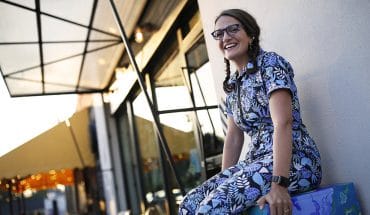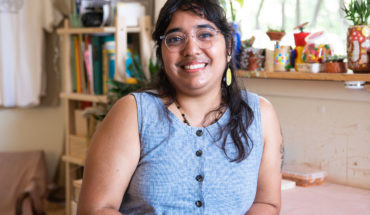Practical Beauty
Gretchen Quinn’s minimalist pottery is meant to be used
by Iza Wojciechowska
photographs by Juli Leonard
Gretchen Quinn doesn’t shy away from messiness. She picks her daughter up from school with smudges on her face, and her puppy visits her pottery studio only to leave with his fur stained red from playing in the clay that’s strewn about. For Quinn, mess is just a necessary part of the process, the long road from rough clay to finished pot.
“For a long time, it is not glamorous – there’s just dirt everywhere and everything’s under plastic,” she says. “But then when you get to the end of the process, and you take everything out of the kiln, and you line it up on the shelves, it’s incredibly satisfying. I love the thought that I can make something, and people will buy it, and it makes them happy.”
Quinn’s final product is not messy. She makes minimalist pottery with a characteristic white glaze and geometric etchings. The large windows of her brightly lit Boylan Heights studio are lined with mugs, bowls, plates, trays, and vases marked with dots, vertical lines, chevrons, or understated petal-like patterns. They’re homey, welcoming, and meticulously crafted, and the mix of patterns mesh into a complementary collection. The appealing simplicity and neutral color palette makes this pottery an ideal blank canvas for flowers, dinner parties, or kitchen shelves.
In fact, part of what drives Quinn is making sure the pieces she makes are functional and down-to-earth. “I like to make things you can use,” she says. “I don’t intend (a bowl) to be something super-special that you’ll leave on a shelf. I want people to be eating out of it and mixing in it and enjoying it.”
Evolution
Quinn began making pottery in college, when she studied sculpture at Providence College in Rhode Island. She then moved to Seattle, where she worked as a graphic designer and continued making pottery on the side. But when her husband’s job (and the prospect of nice weather) brought Quinn to Raleigh four years ago, pottery finally became a full-time endeavor for her. She supplements it by teaching wheel and hand-building pottery classes at N.C. State’s Crafts Center and the Pullen Arts Center.
Though she’s always been drawn to making “clean, functional, thoughtful shapes,” Quinn’s pottery has evolved over the years, a result of both practicality and of her maturing aesthetic.
She used to experiment with colors in her work and incorporate lace imprints. When she moved into her studio in Raleigh, she began using a single clay body and a single glaze, because it was easier to find and more affordable. She intended to go this practical route for just a year, until she got settled, but the techniques stuck. Now her narrow focus on materials unifies her work and distinguishes her among Triangle potters.
Her designs also grew tighter and simpler. She identified ideal shapes for her pottery, ones that allowed her to move past a phase where she “could not sell a mug to save (her) soul.” She abandoned lace in favor of hand-etched designs that are rooted in her upbringing. Growing up in New England in the 1970s, Quinn’s world was filled with Scandinavian design, minimalist Shaker furniture, and floral Marimekko prints. She combined the clean lines and prints from these influences, toned them down a bit, and added her own graphic design aesthetic to land at her distinctive patterns.
‘Hands touched it’
She etches the patterns into her pottery freehand. Apart from deciding which design a certain bowl or vase will receive, she doesn’t use templates or plan extensively. She just begins: dots down the middle spaced out approximately so; a chevron design lining a tray, perhaps an extra little line here, a larger space there, or a quilt-like petal pattern circling a mug. Doing it this way isn’t always perfect. Lines don’t always connect on the other side of a bowl, or a circle isn’t perfectly round, or dots aren’t always the same size. But these “flaws,” if one wants to call them that, are all part of the process, part of the beauty of the art.
“It makes it obvious that hands touched it,” Quinn says. “Even if it’s not the most beautiful piece you’ve ever seen, you can tell that somebody worked on it instead of it being factory-made and in a store with 10,000 that look exactly like it.”
In part, Quinn credits her move to Raleigh with her ability to thrive as an artist. She delights in the vibrant and welcoming pottery community here, in her deep-dive into teaching (which she says also makes her a better artist), and in the people she encounters at craft markets and art walks who love her work, who want her bowls and vases and plates in their homes.
Quinn still seems surprised every time someone wants to buy her work, still shocked that she’s been able to develop her hobby into a true career. But she’s already thinking ahead to new projects: She hopes to add lamps to her existing collection in the coming months, and she might even dip into color again.








